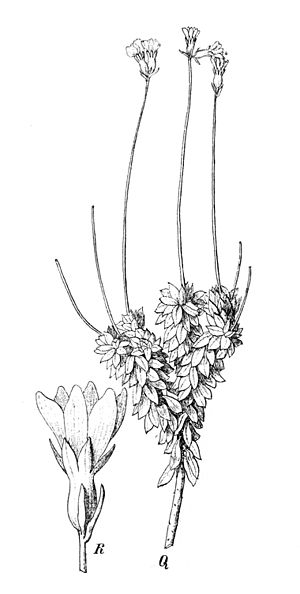Forstera facts for kids
Quick facts for kids Forstera |
|
|---|---|
 |
|
| Forstera bidwillii illustration from Johannes Mildbraed's 1908 monograph on the Stylidiaceae. | |
| Scientific classification |
|
| Kingdom: | Plantae |
| Clade: | Tracheophytes |
| Clade: | Angiosperms |
| Clade: | Eudicots |
| Clade: | Asterids |
| Order: | Asterales |
| Family: | Stylidiaceae |
| Subfamily: | Stylidioideae |
| Genus: | Forstera L. ex G.Forst. |
| Type species | |
| Forstera sedifolia G.Forst.
|
|
| Species | |
|
|
Forstera is a group of small plants that live for many years. These plants belong to the Stylidiaceae family. They were named after two German naturalists, Johann Reinhold Forster and his son, Georg Forster. The Forsters had already described a similar plant group called Phyllachne five years before.
There are five different types, or species, of Forstera plants. Most of them are found only in New Zealand. However, one species, F. bellidifolia, is found only in Tasmania. Forstera plants look a bit like some plants in a related group called Stylidium, but they are actually more closely related to Phyllachne.
What do Forstera Plants Look Like?
Forstera plants are usually small and grow upright or spread along the ground. They have tiny leaves that overlap each other, like scales. Their flowers are on stalks and are shaped like a star, meaning they are symmetrical all around.
Forstera plants share some special features with their close relatives, Phyllachne. For example, their pollen-producing parts (called anthers) are joined at the top and form a single curved part. They also have special nectar glands located above the ovary. You can tell Forstera apart from Phyllachne because Forstera has long flower stalks, which Phyllachne does not. Also, Phyllachne plants often grow in a dense, cushion-like shape.
How Forstera Plants Were Discovered
The group of plants known as Forstera was first named by Carl Linnaeus. It was officially described in 1780 by Georg Forster. The first species to be placed in this group was F. sedifolia. For 72 years, this was the only known Forstera species.
Then, in the mid-1800s, an English botanist named Sir Joseph Dalton Hooker discovered and described three new species. He found F. bellidifolia in 1852, and then F. bidwillii and F. tenella in 1853.
For a while, scientists weren't sure if these plants should be in one group or two separate ones. In 1874, Ferdinand von Mueller moved some Forstera species into the Phyllachne group. Later, in 1889, Selmar Schönland even suggested that Forstera should just be a small part of Phyllachne. These changes showed how closely related the two plant groups are. By 1908, all four known species were put back into the Forstera group by Johannes Mildbraed. The most recent species, F. mackayii, was discovered in 1935 by Harry Allan. This brought the total number of Forstera species to five.
See also
 In Spanish: Forstera para niños
In Spanish: Forstera para niños

